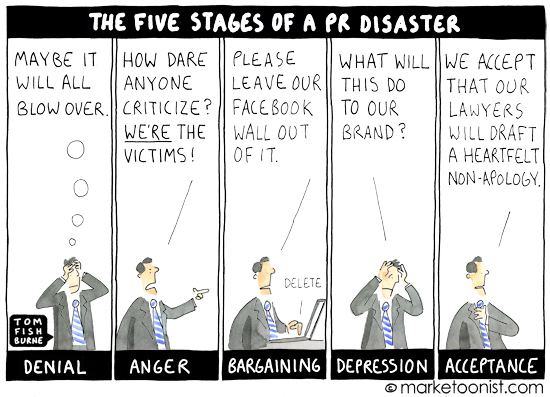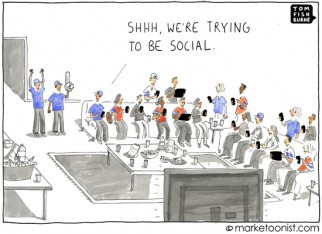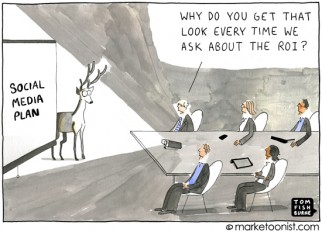I started sketching this cartoon weeks ago after hearing that Carnival offered a voucher for 30% off future cruises to passengers of the Costa Condordia. Coincidentally this was before last week’s dramatic blunders of Susan G Komen for the Cure.
PR crises are nothing new. The field of crisis management originated with the environmental and industrial disasters of the 1980’s (Exxon Valdez, Tylenol). But they are more acute than ever thanks to social media. How a brand handles itself in a crisis is a far greater litmus test of what the brand stands for than any mission statement it writes or marketing plan it executes.
Most brands won’t face a PR disaster at the same scale of a sinking ship or rebuke from Senators. But every brand does face crisis: an ad that offends, a product malfunction, a spokesperson caught in an infidelity scandal.
Brand teams should spend time thinking about how they would handle a crisis, large or small. Marketers can’t plan for every single thing that could go wrong, but they should establish ground rules. And make sure that they have the right team in place. Waiting until a crisis happens is too late.
I like the perspective of Jason Fried, co-founder of 37signals. In an Inc. magazine column last year, he detailed how 37signals handled a product disaster, mainly by being human.
“I’ve been a customer of companies that don’t know how to respond to a crisis. These outfits don’t own up to the problem. They hedge, they tiptoe, they get their PR departments to issue abstract nonapology apologies.”
“People don’t judge you on the basis of your mistakes—they judge you on the manner in which you own up to them. In my experience, most companies do a terrible job of taking blame. They lob press releases. Or they apologize for the inconvenience. Resist that temptation and say you’re sorry like you’re apologizing to a friend. Be good—and your customers will be good right back to you.”
(Marketoonist Monday: I’m giving away a signed print of this week’s cartoon. Just share an insightful comment to this week’s post. I’ll pick one comment by 5:00 PST on Monday. Thanks!)



Dan Thornton says
There must be something in the water, because I’ve just written the same message regarding how brands react, but from the perspective of sports fans on the day of the Superbowl, Chelsea vs Manchester Utd and Ireland vs Wales in rugby…
http://thewayoftheweb.net/2012/02/what-brands-need-to-learn-about-true-fans/
Paul Copcutt says
Tom how did you get hold of the Susan G Komen PR Manual – The 5 Steps to Handling Any Questionable Decision?!!!!
Courtney Bosch says
Great post! Companies can no longer sit mum during a crisis. Owning up and addressing it have come to be expected.
Geoff Vincent says
“heartfelt non-apology” …hilarious! Reminds me of the similar “if I’ve offended anyone” non-apology.
Leslie says
It’s interesting that you didn’t mention Zappos and their server being hacked into. Maybe that’s because they handled the situation correctly?!
David Sprogis says
It is especially interesting when a service organization runs aground, as did Carnival, and does not know how to recover with grace.
Disney instructs that the brand is the sum total of all interactions, typically face-to-face, typically with front-line staff. Front-line staff are often instructed in Service Recovery – how to manage all those little routine crises that occur every day. Yet, in circumstances such as these, we see that the top of the company is unskilled in recovery.
Susan says
I think most PR disasters are much more a failure of CEO leadership than a failure by PR &/or marketing teams … there’s only so much PR/marketing can do when leaders fail to own their bad decisions and their version of “acceptance” is legal-esey non-apology. I can’t imagine who thought couponing for future PURCHASES was any kind of an appropriate response to major grief/trauma/death!? I thought captain who abandoned ship had my vote for “worst leader of year” award, but maybe it should go to whoever approved couponing idea?: http://www.businessmanagementdaily.com/29798/early-contender-for-worst-leader-of-2012
Cheryl Ann says
Thanks for the great cartoon, Tom. Not only are the stages funny–but they’re supported by academic scholarship. Notice the similarity between your stages of a PR disaster and Benoit’s (1997) Image Restoration strategies: Denial, Evasion of responsibility, Reducing offensiveness of event, Corrective action, Mortification. In the “Mortification” strategy, companies confess and beg forgiveness. According to Benoit, “A potential drawback to this strategy is that it might invite lawsuits from victims” (p. 181). What’s mortifying is the focus on lawsuits and not victims.
Mari says
As much as Komen’s case can go in the history as a guide on “how to destroy a brand in 48 hours”, I think everybody is missing how genius Planned Parenthood actions were. They knew about Komen’s decision to cut grants since December and suddenly in February they call it “breaking news” and they claim to need “emergency funds” when Komen’s grants were less than 1% of their budget. They raised half a million in one day, further strenghen their emotional connection with their supporters and for once, they became the victim when they are usually called the bad guys by many. Pure genius.
Lynn says
Owning up to a mistake quickly can make all the difference. Red Cross has an incident last year that could have gotten away from them (http://www.brandchannel.com/home/post/2011/02/22/Red-Cross-Twitter-Mistake.aspx) but instead brought some good press. While this was not on the same level as the Komen debacle, it shows that you can handle PR mistakes in a way that turns it to your benefit. The fact that Komen went back and forth on their “explanations” and then gave the whiniest apology possible (stop vilifying us! wah!) just made it worse.
Lisa Hahn says
Perfect! This is how too many companies view a crisis. It’s all about them, not about the consumer or citizen. Too many times I’ve seen lawyers step in and clients refuse to address an issue with their stakeholders. These misguided CEOs think their business will survive dispite public outrage. I’d love to share your drawing with folks. Well done!
Rob says
A classic in the making has been J&J’s approach to dealing with the Tylenol recall – stuttering steps and taking ownership only after Congressional investigations. Their performance (or lack) is a case study in avoidance and (I suspect) legally directed non-statements. The fear I think company’s have to owning up to a mistake is the legal mess that follows, but they often forget that they are already in that mess for better or for worse.
tomfishburne says
Hi all,
Fantastic commentary this week, many thanks! Great to reference other classic PR case studies, from Zappos to Planned Parenthood to Red Cross to J&J. Yesterday was one of my highest-traffic days on the website. This is a hot topic, and I’m contributing to a Fast Company column later this week on this that I’ll share with you.
This week’s cartoon print goes to Susan for the critical reminder that PR goes far deeper than a PR team or a marketing team. It connects to the heart of leadership of a brand or business. If a PR team’s job is only to play clean-up, rather than have a constant seat at the table, it’s far too late.
Thanks!
-Tom
April Kelcy says
Thank you for this. It is memorable as it reflects the classic Elizabeth Kubler-Ross stages of death and dying. And companies and people will live and die according to their values, not just their planning. Notice that at every stage, the focus is on the “me”, and not on the customers, clients, audiences or public that any business or agency claims to want to serve. The cartoon is not only profound and easy to remember, the quickness of it captures how quickly PR events typically unfold. As an emergency management consultant I would love to have permission to use this from time to time with select clients.
Natalie says
After seeing many people shift blame for mistakes instead of just accepting that they’re human and apologising, this article is refreshing. We are human and we all make mistakes. We also need to realise and accept others make mistakes too and forgive them not crucify them or think less of them for admitting it.
LaShunda Campbell says
The cartoon is a true illustration of how the crisis communications process typically works. It’s just the nature of businesses to run for the extinguishers when a fire starts, instead of developing a fire prevention plan to begin with.
– @eLLeCee404
Tom Maddocks says
Great cartoon. Too many companies when faced with a crisis fall into a panic because they don’t have senior people who are used to dealing with the media on a regular basis. Suddenly they’re in a media firestorm and they panic – or just hide, and this makes things even worse, as with Carnival. Every big corporation should have enough well media-trained spokespeople who understand the game and can come across to reporters and on TV as sincere – as opposed to the rabbit in the headlights. For more on managing a PR crisis visit http://www.mediatrainingassociates.co.uk/home/
Susan says
Interested in your commentary, Tom on UVA’s own PR disaster… if you decide to blog about it… lots of theories/investigative reporting as to real story behind the ouster of first female president compiled here http://www.annemarieangelo.com/
Samra Bufkins, MJ, APR says
Wow, how did two years go by without my seeing this? I’m definitely showing this to my public relations students.